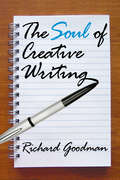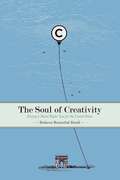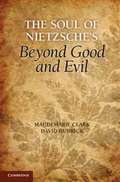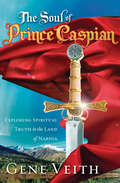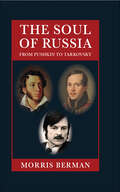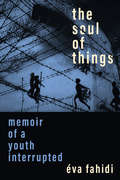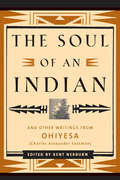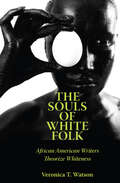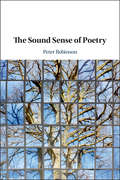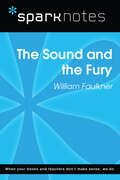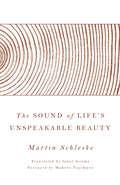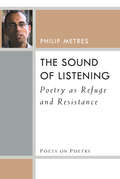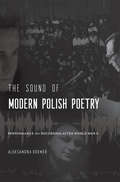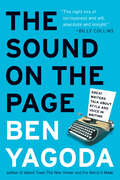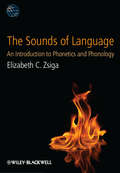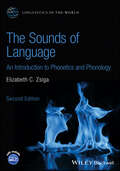- Table View
- List View
The Soul of Creative Writing
by Richard Goodman"I have a faith in language," said the poet W. S. Merwin. "It's the ultimate achievement that we as a species have evolved so far." Language is a deep ocean of living words, as varied as undersea life. It is a gift inherited by each person when he or she is born; it can be corrupted and regulated, but it cannot be owned. It is an enormous, complex, inexhaustible gift. The Soul of Creative Writing is a tribute to language and to its potentials. It explores the elements of language, style, rhythm, sound, and the choice of the right word. Richard Goodman paints an image of how language can produce a life and meaning that otherwise cannot exist in the symbols themselves.Goodman's stunningly creative collection was written after a lifetime of working and struggling with language. He collects rich examples from writers of the past and present, both great and small, and uses them to illustrate how each element of our written language can be used. The book begins with an analysis of words and how they can be used to create music on the page. Goodman uncovers the strength of words, writing about the shades of meaning that make the search for the exact word both arduous and immensely rewarding. He discusses how to find the proper title and how to find a fitting subject. He show how to create nonfiction work that is vivid and memorable through the use of the same techniques fiction writers employ.Goodman's volume is written with humor and clarity--with fascination and reverence. Writers will find it an indispensable source of creative inspiration and instruction. In Goodman's words, "reading is a tour of a writer's efforts at manipulating language to create art, to create flesh and blood and mountains, cities, homes, and gardens out of inky symbols on the page." To literary critics, this book will be a guide to understanding the tools and devices of great writing.
The Soul of Creativity
by Roberta Rosenthal KwallIn the United States, human creativity is historically understood to be motivated by economic concerns. However, this perspective fails to account for the reality that human creativity is also often the result of internal motivations having nothing to do with money. This book addresses what motivates human creativity and how the law governing authors' rights should be shaped in response to these motivations. On a practical level, it illustrates how integrating a fuller appreciation of the inspirational dimension of the creative process will allow us to think more expansively about legal protections for authors. Many types of creators currently lack the legal ability to compel attribution for their work, to prevent misattribution, and to safeguard their work from unwanted modifications. Drawing from a number of diverse sources, including literary, philosophical, and religious works, this book offers real solutions for crafting legal measures that facilitate an author's ability to safeguard his or her work without entirely sacrificing the intellectual property policies in practice in the United States today.
The Soul of Nietzsche'S beyond Good and Evil
by Maudemarie Clark David DudrickThis book presents a provocative new interpretation of Beyond Good and Evil, arguably Nietzsche's most important work. The problem is that it appears to express merely a loosely connected set of often questionable opinions. Can Nietzsche really be an important philosopher if this is his most important book? Maudemarie Clark and David Dudrick address this question with a close reading that emphasizes how Nietzsche writes. They argue that the first part of Beyond Good and Evil presents coherent and interconnected arguments for subtle and well-thought-out positions on traditional issues. Nietzsche's infamous doctrine of the will to power turns out to be a compelling account of the structure and origin of the human soul. And although he rejects some aspects of traditional philosophy, Nietzsche's aim is to show how philosophy's traditional aspirations to seek both the true and the good can be fulfilled. Beyond Good and Evil turns out to be a major work of philosophy and Nietzsche's masterpiece.
The Soul of Prince Caspian
by Gene VeithThrough best-selling books and now blockbuster motion pictures, C. S. Lewis's masterpiece "The Chronicles of Narnia" has captured the hearts and imaginations of millions of children and adults. When Lewis wrote this acclaimed series more than half a century ago, many considered it a mere children's allegory and missed the rich spiritual meaning of the Christian faith that Lewis was clearly communicating.In The Soul of the Lion, the Witch and the Wardrobe, Gene Veith revealed the mysteries and meanings of the first Narnia book. And now with the motion picture release of the second in the series, Veith returns to dig deeply into the biblical message behind this beloved story.In The Soul of Prince Caspian, Veith reveals how Lewis takes on the modern mindset that has literally forgotten Christ--just as Narnia has forgotten Aslan. As Veith unlocks the story of Prince Caspian, you'll discover how Lewis's other writings add depth and clarity to his message. And you'll see that, while Prince Caspian may be about the fantastic land of Narnia, it's also about your world.
The Soul of Russia: From Pushkin to Tarkovsky
by Morris Berman"Ecstasy, witchcraft, bewilderment-these ten loving vignettes on scandalous corners of Russian culture, by one of our most seasoned cultural critics, are a tribute to imperishable art even in our catastrophic time." -Caryl Emerson, Professor Emerita of Slavic Languages and Literatures, Princeton University In terms of literature, music, and film, it would be hard to outdo the sheer genius and creativity of Russia. These things constitute the soul of the nation, and it is this that Morris Berman explores in his latest work, The Soul of Russia. His central argument is that at the heart of this brilliance lies a particular idiosyncratic theme: the peasant-shamanic-folkloric tradition of the Russian people, which these artists, from Pushkin to Tarkovsky, drew upon for their inspiration. It was a "Dionysian" source, a nonrational one, and it endowed Russian creative work with what we would have to call vibrancy. Berman presents ten Russian artists who have left their indelible imprint on our collective consciousness. Pushkin offers a supernatural puzzle that Russian scholars are still trying to solve to this day. Gogol tells a tale of a man who wakes up to discover he has lost his nose, and goes in search of it-while his nose has simultaneously taken on a life of its own. Andrei Bely, in Petersburg, explains the revolution of 1905 not through traditional sociological or historical analysis, but by means of a surreal panorama of Oedipal events. Chekhov wittily explores the erotic properties of food, while Diaghilev shocks Europe with the great Vaslav Nijinsky and the Ballets Russes. Composing for this radical dance company, Stravinsky manages to alter the face of music forever. Mikhail Bulgakov offers one of the greatest novels of the twentieth century, The Master and Margarita, and Tarkovsky responds to Stanley Kubrick's famous 2001: A Space Odyssey by coming up with Solaris, a film based not on superficial American techno-fetishism but on questions of love, reality, and human identity. The Soul of Russia is a feast for the mind, but also for the senses-a book that readers will want to delve into more than once.
The Soul of Things: Memoir of a Youth Interrupted
by Éva FahidiAn exceptional document of an extraordinary life, The Soul of Things is the memoir of Holocaust survivor Éva Fahidi. Since the memoir was first published in Hungarian in 2004 under the title Anima Rerum, Fahidi has become a household name in Hungary and in Germany. Featured in countless interviews and several prize-winning documentary films, at the age of ninety-five she is a frequent speaker at Holocaust commemorations in Hungary, Germany, and elsewhere. The Soul of Things combines a rare depiction of upper-middle-class Jewish life in pre-war Hungary with the chronicle of a woman’s deportation and survival in the camps. Fahidi is a gifted writer with a unique voice, full of wisdom, humanity, and flashes of dark humour. With an unsentimental, philosophical perspective, she recounts her journey from the Great Hungarian Plain to the extermination camp of Auschwitz-Birkenau, the forced labour camp of Münchmühle, and back. The English edition includes a new introduction by historians Éva Kovács and Judith Szapor, the original prefaces to the Hungarian and German editions, an essay on the Münchmüle Camp by Fritz Brinkman-Frisch, and extensive notes providing historical and cultural context for Fahidi’s narrative.
The Soul of an Indian
by Kent NerburnOhiyesa, a Dakota Indian also known as Charles Alexander Eastman, is one of America's most fascinating and overlooked individuals. Born in Minnesota in 1858, he obtained postgraduate degrees and advised U.S. presidents before returning to traditional living in native forests. This reissue contains Ohiyesa's insights on spirit, the human experience, and white culture's impact on Native American culture.
The Souls of Mixed Folk: Race, Politics, and Aesthetics in the New Millennium
by Michele ElamThe Souls of Mixed Folk examines representations of mixed race in literature and the arts that redefine new millennial aesthetics and politics. Focusing on black-white mixes, Elam analyzes expressive works--novels, drama, graphic narrative, late-night television, art installations--as artistic rejoinders to the perception that post-Civil Rights politics are bereft and post-Black art is apolitical. Reorienting attention to the cultural invention of mixed race from the social sciences to the humanities, Elam considers the creative work of Lezley Saar, Aaron McGruder, Nate Creekmore, Danzy Senna, Colson Whitehead, Emily Raboteau, Carl Hancock Rux, and Dave Chappelle. All these writers and artists address mixed race as both an aesthetic challenge and a social concern, and together, they gesture toward a poetics of social justice for the "mulatto millennium." The Souls of Mixed Folk seeks a middle way between competing hagiographic and apocalyptic impulses in mixed race scholarship, between those who proselytize mixed race as the great hallelujah to the "race problem" and those who can only hear the alarmist bells of civil rights destruction. Both approaches can obscure some of the more critically astute engagements with new millennial iterations of mixed race by the multi-generic cohort of contemporary writers, artists, and performers discussed in this book. The Souls of Mixed Folkoffers case studies of their creative work in an effort to expand the contemporary idiom about mixed race in the so-called post-race moment, asking how might new millennial expressive forms suggest an aesthetics of mixed race? And how might such an aesthetics productively reimagine the relations between race, art, and social equity in the twenty-first century?
The Souls of White Folk: African American Writers Theorize Whiteness (Margaret Walker Alexander Series in African American Studies)
by Veronica T. WatsonThe Souls of White Folk: African American Writers Theorize Whiteness is the first study to consider the substantial body of African American writing that critiques whiteness as social construction and racial identity. Arguing against the prevailing approach to these texts that says African American writers retreated from issues of “race” when they wrote about whiteness, Veronica T. Watson instead identifies this body of literature as an African American intellectual and literary tradition that she names “the literature of white estrangement.” In chapters that theorize white double consciousness (W. E. B. Du Bois and Charles W. Chesnutt), white womanhood and class identity (Zora Neale Hurston and Frank Yerby), and the socio-spatial subjectivity of southern whites during the civil rights era (Melba Patillo Beals), Watson explores the historically situated theories and analyses of whiteness provided by the literature of white estrangement from the late-nineteenth through the mid-twentieth centuries. She argues that these texts are best understood as part of a multipronged approach by African American writers to challenge and dismantle white supremacy in the United States and demonstrates that these texts have an important place in the growing field of critical whiteness studies.
The Sound Sense of Poetry: Volume 1
by Peter RobinsonWhat real role can poetry have in the world? How are its truths created by the words and sounds chosen by the poet and by the way readers respond to them? Acclaimed poet Peter Robinson brings his knowledge of poetic art to the understanding of the reader's contribution in enabling poetry to play its part in life. Emphasising the value of individual writers' and readers' interactions, together with such key matters as meter and rhythm, voicing and form, rhyme and syntax, Robinson shows how poems engage in speech performances such as promising, justifying, excusing, and explaining - including the telling of truths. Illustrated with detailed readings of poems by, among others, Jonson, Marvell, Blake, Wordsworth, Coleridge, Tennyson, Christina Rossetti, Dickinson, Kipling, Basil Bunting, Frank O'Hara, Tony Harrison, and Denise Riley, this book shows how important poetry is as a means to do things with words and make things happen.
The Sound and the Fury (MAXNotes Literature Guides)
by Boria SaxREA's MAXnotes for William Faulkner's The Sound and the Fury MAXnotes offer a fresh look at masterpieces of literature, presented in a lively and interesting fashion. Written by literary experts who currently teach the subject, MAXnotes will enhance your understanding and enjoyment of the work. MAXnotes are designed to stimulate independent thought about the literary work by raising various issues and thought-provoking ideas and questions. MAXnotes cover the essentials of what one should know about each work, including an overall summary, character lists, an explanation and discussion of the plot, the work's historical context, illustrations to convey the mood of the work, and a biography of the author. Each section of the work is individually summarized and analyzed, and has study questions and answers.
The Sound and the Fury (SparkNotes Literature Guide Series)
by SparkNotesThe Sound and the Fury (SparkNotes Literature Guide) by William Faulkner Making the reading experience fun! Created by Harvard students for students everywhere, SparkNotes is a new breed of study guide: smarter, better, faster. Geared to what today's students need to know, SparkNotes provides: *Chapter-by-chapter analysis *Explanations of key themes, motifs, and symbols *A review quiz and essay topicsLively and accessible, these guides are perfect for late-night studying and writing papers
The Sound of Culture: Diaspora and Black Technopoetics
by Louis Chude-SokeiThe Sound of Culture explores the histories of race and technology in a world made by slavery, colonialism, and industrialization. Beginning in the late nineteenth century and moving through to the twenty-first, the book argues for the dependent nature of those histories. Looking at American, British, and Caribbean literature, it distills a diverse range of subject matter: minstrelsy, Victorian science fiction, cybertheory, and artificial intelligence. All of these facets, according to Louis Chude-Sokei, are part of a history in which music has been central to the equation that links blacks and machines. As Chude-Sokei shows, science fiction itself has roots in racial anxieties and he traces those anxieties across two centuries and a range of writers and thinkers—from Samuel Butler, Herman Melville, and Edgar Rice Burroughs to Sigmund Freud, William Gibson, and Donna Haraway, to Norbert Weiner, Sylvia Wynter, and Samuel R. Delany.
The Sound of Life's Unspeakable Beauty
by Martin Schleske&“In the final analysis, music is prayer cast into sound.&” One of the greatest luthiers of our time reveals the secrets of his profession—and how each phase of handcrafting a violin can point us toward our calling, our true selves, and the overwhelming power and gentleness of God&’s love. Schleske explains that our world is flooded with metaphors, parables, and messages from God. But are we truly listening? Do we really see? Drawing upon Scripture, his life experiences, and his insights as a master violinmaker, Schleske challenges readers to understand the world, ourselves, and the Creator in fresh ways. The message of this unique book is mirrored in sensitive photographs by Donata Wenders, whose work has appeared in prominent newspapers and magazines, including The New York Times, Rolling Stone, and Esquire, as well as museums and galleries throughout the world.
The Sound of Life's Unspeakable Beauty
by Martin SchleskeChristianity Today Book Award in Culture and the Arts (2021) &“In the final analysis, music is prayer cast into sound.&” One of the greatest luthiers of our time reveals the secrets of his profession—and how each phase of handcrafting a violin can point us toward our calling, our true selves, and the overwhelming power and gentleness of God&’s love. Schleske explains that our world is flooded with metaphors, parables, and messages from God. But are we truly listening? Do we really see? Drawing upon Scripture, his life experiences, and his insights as a master violinmaker, Schleske challenges readers to understand the world, ourselves, and the Creator in fresh ways. The message of this unique book is mirrored in sensitive photographs by Donata Wenders, whose work has appeared in prominent newspapers and magazines, including The New York Times, Rolling Stone, and Esquire, as well as museums and galleries throughout the world.
The Sound of Listening: Poetry as Refuge and Resistance (Poets On Poetry)
by Philip MetresPhilip Metres stakes a claim for the cultural work that poems can perform—from providing refuge to embodying resistance, from recovering silenced voices to building a more just world, in communities of solitude and solidarity. Gathering a decade of his writing on poetry, he widens our sense of poetry as a way of being in the world, proposing that poems can offer a permeability to marginalized voices and a shelter from the imperial noise and despair that can silence us. The Sound of Listening ranges between expansive surveys of the poetry of 9/11, Arab American poetry, documentary poetry, landscape poetry, installation poetry, and peace poetry; personal explorations of poets such as Adrienne Rich, Khalil Gibran, Lev Rubinstein, and Arseny Tarkovsky; and intimate dialogues with Randa Jarrar, Fady Joudah, and Micah Cavaleri, that illuminate Metres’s practice of listening in his 2015 work, Sand Opera.
The Sound of Modern Polish Poetry: Performance and Recording after World War II
by Aleksandra KremerAn illuminating new study of modern Polish verse in performance, offering a major reassessment of the roles of poets and poetry in twentieth-century Polish culture. What’s in a voice? Why record oneself reading a poem that also exists on paper? In recent decades, scholars have sought to answer these questions, giving due credit to the art of poetry performance in the anglophone world. Now Aleksandra Kremer trains a sharp ear on modern Polish poetry, assessing the rising importance of authorial sound recordings during the tumultuous twentieth century in Eastern Europe. Kremer traces the adoption by key Polish poets of performance practices intimately tied to new media. In Polish hands, tape recording became something different from what it had been in the West, shaped by its distinctive origins behind the Iron Curtain. The Sound of Modern Polish Poetry reconstructs the historical conditions, audio technologies, and personal motivations that informed poetic performances by such luminaries as Czesław Miłosz, Wisława Szymborska, Aleksander Wat, Zbigniew Herbert, Miron Białoszewski, Anna Swir, and Tadeusz Różewicz. Through performances both public and private, prepared and improvised, professional and amateur, these poets tested the possibilities of the physical voice and introduced new poetic practices, reading styles, and genres to the Polish literary scene. Recording became, for these artists, a means of announcing their ambiguous place between worlds. Kremer’s is a work of criticism as well as recovery, deploying speech-analysis software to shed light on forgotten audio experiments—from poetic “sound postcards,” to unusual home performances, to the final testaments of writer-performers. Collectively, their voices reveal new aesthetics of poetry reading and novel concepts of the poetic self.
The Sound of Shakespeare (Accents on Shakespeare)
by Wes FolkerthThe 'Sound of Shakespeare' reveals the surprising extent to which Shakespeare's art is informed by the various attitudes, beliefs, practices and discourses that pertained to sound and hearing in his culture. In this engaging study, Wes Folkerth develops listening as a critical practice, attending to the ways in which Shakespeare's plays express their author's awareness of early modern associations between sound and particular forms of ethical and aesthetic experience. Through readings of the acoustic representation of deep subjectivity in Richard III, of the 'public ear' in Antony and Cleopatra, the receptive ear in Coriolanus, the grotesque ear in A Midsummer Night's Dream, the 'greedy ear' in Othello, and the 'willing ear' in Measure for Measure, Folkerth demonstrates that by listening to Shakespeare himself listening, we derive a fuller understanding of why his works continue to resonate so strongly with is today.
The Sound of the Kiss, or The Story That Must Never Be Told (Translations from the Asian Classics)
by Pingali SurannaComposed in the mid-sixteenth century, The Sound of the Kiss, or The Story That Must Never Be Told, could be considered the first novel written in South Asia. Telugu, the language spoken in today's Andhra Pradesh region of southern India, has a classical literary tradition extending over a thousand years. Suranna's masterpiece comes from a period of intense creativity in Telugu, when great poets produced strikingly modern innovations. The novel explodes preconceived ideas about early South Indian literature: for example, that the characters lack interiority, that the language is formulaic, and that Telugu texts are mere translations of earlier Sanskrit works. Employing the poetic style known as campu, which mixes verse and prose, Pingali Suranna's work transcends our notions of traditional narrative. "I wanted to have the structure of a complex narrative no one had ever known," he said of his great novel, "with rich evocations of erotic love, and also descriptions of gods and temples that would be a joy to listen to."The Sound of the Kiss is both a gripping love story and a profound meditation on mind and language. Shulman and Rao include a thorough introduction that provides a broader understanding of, and appreciation for, the complexities and subtleties of this text.
The Sound on the Page: Great Writers Talk about Style and Voice in Writing
by Ben YagodaThe acclaimed author examines the importance of a writer&’s voice—including interviews with Susan Orlean, Michel Chabon, Junot Díaz and others. In writing, style matters. Our favorite writers often entertain, move, and inspire us less by what they say than by how they say it. In The Sound on the Page, acclaimed author, teacher, and critic Ben Yagoda offers practical and incisive help for writers on developing and discovering their own style and voice. This wonderfully rich and readable book features interviews with more than 40 of our most important authors discussing their literary style, including: Dave Barry Harold Bloom Supreme Court Justice Stephen Breyer Bill Bryson Michael Chabon Andrei Codrescu Junot Díaz Adam Gopnik Jamaica Kincaid Michael Kinsley Elmore Leonard Elizabeth McCracken Susan Orlean Cynthia Ozick Anna Quindlen Jonathan Raban David Thomson Tobias Wolff
The Sounds of English Around the World: An Introduction to Phonetics and Phonology
by Jette G. Hansen EdwardsMost introductions to English phonetics and phonology focus primarily on British or American English, which fails to account for the rich diversity of English varieties globally. This book addresses this gap, providing an overview of English phonetics and phonology through an exploration of the sounds of English around the world, including older varieties of English such as American, Canadian, British, and Australian Englishes, as well as new varieties of English such as Indian, Singaporean, Hong Kong, and Kenyan English. It focuses on diversity in vowels and consonants, allophonic variation, and stress and intonation patterns across regional, ethnic and social varieties of English in North America, The Caribbean, Asia, Africa, Europe, and Oceania. Listening exercises are incorporated throughout to facilitate the understanding of different concepts, and the book also has an accompanying website with a wide range of speech samples, allowing readers to hear the phonetics of the varieties under discussion.
The Sounds of Language
by Elizabeth C. ZsigaThe Sounds of Language is an introductory guide to the linguistic study of speech sounds, which provides uniquely balanced coverage of both phonology and phonetics.Features exercises and problem sets, as well as supporting online resources at www.wiley.com/go/zsiga, including additional discussion questions and exercises, as well as links to further resources such as sound files, video files, and useful websitesCreates opportunities for students to practice data analysis and hypothesis testingIntegrates data on sociolinguistic variation, first language acquisition, and second language learningExplores diverse topics ranging from the practical, such as how to make good digital recordings, make a palatogram, solve a phoneme/allophone problem, or read a spectrogram; to the theoretical, including the role of markedness in linguistic theory, the necessity of abstraction, features and formal notation, issues in speech perception as distinct from hearing, and modelling sociolinguistic and other variationsOrganized specifically to fit the needs of undergraduate students of phonetics and phonology, and is structured in a way which enables instructors to use the text both for a single semester phonetics and phonology course or for a two-course sequence
The Sounds of Language: An Introduction to Phonetics (Learning about Language)
by Henry RogersPhonetics is the scientific study of sounds used in language- how the sounds are produced, how they are transferred from the speaker to the hearer and how they are heard and perceived. The Sounds of Language provides an accessible, general introduction to phonetics with a special emphasis on English. Focusing on the phonetics of English, the first section allows students to get an overall view of the subject. Two standard accents of English are presented- RP (Received Pronunciation), the standard accent of England, and GA (General American), the standard accent throughout much of North America. The discussion is arranged so that students can read only the RP or GA portions, if desired. Sixteen additional accents of English spoken around the world are also covered to provide students with wider international coverage.The author then moves on to introduce acoustics phonetics in an accessible manner for those without a science background. The last section of the book provides a detailed discussion of all aspects of speech with extensive examples from languages around the world.Containing student-friendly features such as extensive exercises for practising the sounds covered in each chapter; a glossary of technical terms; instructions on how to write phonetic symbols; the latest International Phonetic Alphabet chart and a detailed list of English consonantal variants, The Sounds of Language provides an excellent introduction to phonetics to students of linguistics and speech pathology and students of English as a second language.
The Sounds of Language: An Introduction to Phonetics and Phonology (Linguistics in the World)
by Elizabeth C. ZsigaThe fully updated, new edition of the bestselling introduction to phonetics and phonology The Sounds of Language presents a comprehensive introduction to both the physical and cognitive aspects of speech sounds. Assuming no prior knowledge of phonetics or phonology, this student-friendly textbook clearly explains fundamental concepts and theories, describes key phonetic and phonological phenomena, explores the history and intersection of the two fields, offers practical advice on collecting and reading data, and more. Twenty-four concise chapters, written in non-technical language, are organized into six sections that each focus on a particular sub-discipline: Articulatory Phonetics, Acoustic Phonetics, Segmental Phonology, Suprasegmental Phonology, the Phonology/Morphology Interface, and Variation and Change. The book's flexible modular approach allows instructors to easily choose, re-order, combine, or skip sections to meet the needs of one- and two-semester courses of varying levels. Now in its second edition, The Sounds of Language contains updated references, new problem sets, new examples, and links to new online material. The new edition features new chapters on Lexical Phonology; Word Structure and Sound Structure; and Variation, Probability, and Phonological Theory. Chapters on Sociolinguistic Variation, Child Language Acquisition, and Adult Language Learning have also been extensively updated and revised. Offering uniquely broad and balanced coverage of the theory and practice of two major branches of linguistics, The Sounds of Language: Covers a wide range of topics in phonetics and phonology, from the anatomy of the vocal tract to the cognitive processes behind the comprehension of speech sounds Features critical reviews of different approaches that have been used to address phonetics and phonology problems Integrates data on sociolinguistic variation, first language acquisition, and second language learning Surveys key phonological theories, common phonological processes, and computational techniques for speech analysis Contains numerous exercises and progressively challenging problem sets that allow students to practice data analysis and hypothesis testing Includes access to a companion website with additional exercises, sound files, and other supporting resources The Sounds of Language: An Introduction to Phonetics and Phonology, Second Edition, remains the ideal textbook for undergraduate and beginning graduate classes on phonology and phonetics, as well as related courses in linguistics, applied linguistics, speech science, language acquisition, and cognitive science programs.
The Sounds of Poetry
by Robert PinskyThe Poet Laureate's clear and entertaining account of how poetry works."Poetry is a vocal, which is to say a bodily, art," Robert Pinsky declares in The Sounds of Poetry. "The medium of poetry is the human body: the column of air inside the chest, shaped into signifying sounds in the larynx and the mouth. In this sense, poetry is as physical or bodily an art as dancing."As Poet Laureate, Pinsky is one of America's best spokesmen for poetry. In this fascinating book, he explains how poets use the "technology" of poetry--its sounds--to create works of art that are "performed" in us when we read them aloud. He devotes brief, informative chapters to accent and duration, syntax and line, like and unlike sounds, blank and free verse. He cites examples from the work of fifty different poets--from Shakespeare, Donne, and Herbert to W. C. Williams, Frost, Elizabeth Bishop, C. K. Williams, Louise Glück, and Frank Bidart.This ideal introductory volume belongs in the library of every poet and student of poetry.
